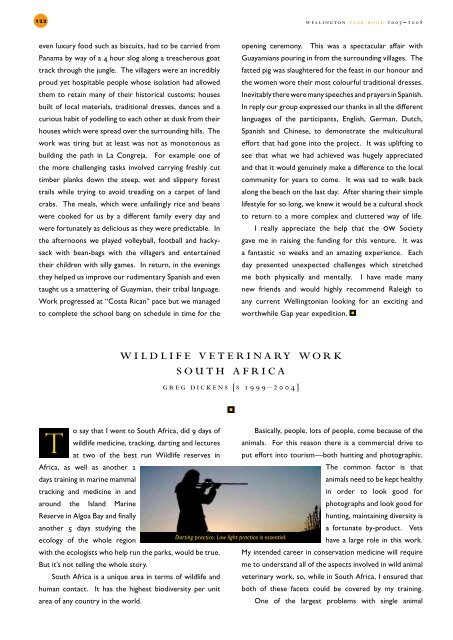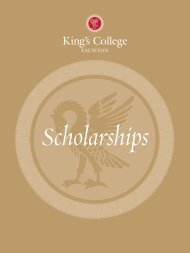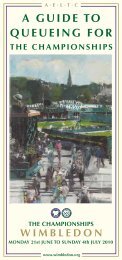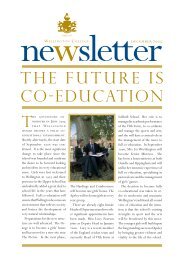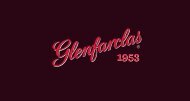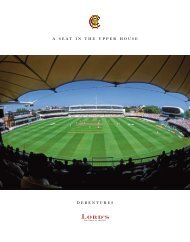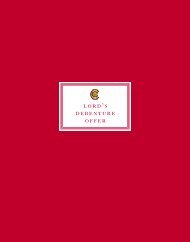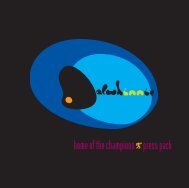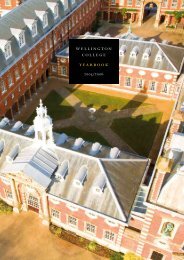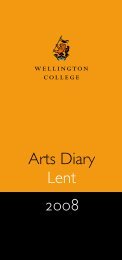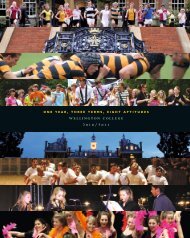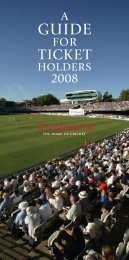golf - Jules Akel
golf - Jules Akel
golf - Jules Akel
- No tags were found...
You also want an ePaper? Increase the reach of your titles
YUMPU automatically turns print PDFs into web optimized ePapers that Google loves.
122 w e l l i ng ton y e a r b oo k 2 0 07 − 2 0 0 8w e l l i ng ton y e a r b oo k 2 0 07 − 2 0 0 8 123even luxury food such as biscuits, had to be carried fromPanama by way of a 4 hour slog along a treacherous goattrack through the jungle. The villagers were an incrediblyproud yet hospitable people whose isolation had allowedthem to retain many of their historical customs: housesbuilt of local materials, traditional dresses, dances and acurious habit of yodelling to each other at dusk from theirhouses which were spread over the surrounding hills. Thework was tiring but at least was not as monotonous asbuilding the path in La Congreja. For example one ofthe more challenging tasks involved carrying freshly cuttimber planks down the steep, wet and slippery foresttrails while trying to avoid treading on a carpet of landcrabs. The meals, which were unfailingly rice and beanswere cooked for us by a different family every day andwere fortunately as delicious as they were predictable. Inthe afternoons we played volleyball, football and hackysackwith bean-bags with the villagers and entertainedtheir children with silly games. In return, in the eveningsthey helped us improve our rudimentary Spanish and eventaught us a smattering of Guaymian, their tribal language.Work progressed at “Costa Rican” pace but we managedto complete the school bang on schedule in time for theopening ceremony. This was a spectacular affair withGuayamians pouring in from the surrounding villages. Thefatted pig was slaughtered for the feast in our honour andthe women wore their most colourful traditional dresses.Inevitably there were many speeches and prayers in Spanish.In reply our group expressed our thanks in all the differentlanguages of the participants, English, German, Dutch,Spanish and Chinese, to demonstrate the multiculturaleffort that had gone into the project. It was uplifting tosee that what we had achieved was hugely appreciatedand that it would genuinely make a difference to the localcommunity for years to come. It was sad to walk backalong the beach on the last day. After sharing their simplelifestyle for so long, we knew it would be a cultural shockto return to a more complex and cluttered way of life.I really appreciate the help that the ow Societygave me in raising the funding for this venture. It wasa fantastic 10 weeks and an amazing experience. Eachday presented unexpected challenges which stretchedme both physically and mentally. I have made manynew friends and would highly recommend Raleigh toany current Wellingtonian looking for an exciting andworthwhile Gap year expedition.w i l d l i f e v e t e r i na ry wor ks ou t h a f r i c ag r e g d i c k e n s [s 1999–200 4]To say that I went to South Africa, did 9 days of Basically, people, lots of people, come because of thewildlife medicine, tracking, darting and lectures animals. For this reason there is a commercial drive toat two of the best run Wildlife reserves in put effort into tourism—both hunting and photographic.Africa, as well as another 2days training in marine mammaltracking and medicine in andThe common factor is thatanimals need to be kept healthyin order to look good foraround the Island Marinephotographs and look good forReserve in Algoa Bay and finallyanother 5 days studying theecology of the whole regionDarting practice. Low light practice is essential.hunting, maintaining diversity isa fortunate by-product. Vetshave a large role in this work.with the ecologists who help run the parks, would be true.But it’s not telling the whole story.South Africa is a unique area in terms of wildlife andhuman contact. It has the highest biodiversity per unitarea of any country in the world.My intended career in conservation medicine will requireme to understand all of the aspects involved in wild animalveterinary work, so, while in South Africa, I ensured thatboth of these facets could be covered by my training.One of the largest problems with single animalI treat a darted male white rhino.veterinary medicine in a wildlife reserve setting is working planning done the night before. A discussion of captureout what to treat. Both of the vets I worked with in South plans to be used followed by an evening calculating dartAfrica would not treat a wounded animal unless it was contents for a range of animal weights and temperamentsvery rare or the injury was human induced.was the norm.On the human safety front, I was instructed on Shamwari and Amakhala reserves, where I worked,dealing with the threats of hazardous terrain, rapid acting are set apart from other reserves in South Africa by theirand lethal drugs, firearms and continual stress. While, on diversity and the potential of the land to sustain variedthe animal side of things, we had to face more dangerous populations of animals. This is due, largely, to the land theyterrain, potential human-animal infection and difficult started with. All of the older and larger reserves were setanæsthetic challenges.up on land that wasn’t much good for anything else. LandThere is often an appreciable anaesthetic hangover that couldn’t be farmed due to poor soil or catastrophicand there will be some form of narcosis from some opioid levels of parasite activity. For example: Kruger, Southanalgesics used. If treated animals are being released back Africa’s first and largest game reserve, was set up on landinto the veld then they will be immediately in danger from that was deemed useless due to the levels of tsetse flies.predators and from competitive members of the same These two newer reserves used strong financial backingspecies. Those which are not fully awake will be injured to convert highly productive farm land into reserve. Andor killed, which negates the point of treating them in the it shows.first place (also, some herbivore anæsthetics are lethal to Nevertheless, in an enclosed system, such as a reservecarnivores, so you’d end up with a dead animal and a pile (not even Kruger is large enough to avoid this) left on theirof dead predators). To counteract this, if the animal was own, one species or other would outstrip its resourcesgoing to be in immediate danger, I reversed all of its anæstheticand any sedatives pharmacologically.of the vet in these parks is to work closely with theand the ecosystem would collapse. So, the other functionAnd finally, due to the problems anæsthetised animals resident ecologist to move animals onto or off the reservehave regulating their temperature, there is a widely to prevent this.acknowledged guideline that restraining wild animals From a practical view point this involved learning aboutshould be avoided if the shade temperature reaches 25°c. finding patterns in the population data, then working outThis meant that days always started before dawn. Which, which animals in a population would be best to move andin turn, encouraged those involved to have all of their then tracking, darting and transport. The problems of wild-


